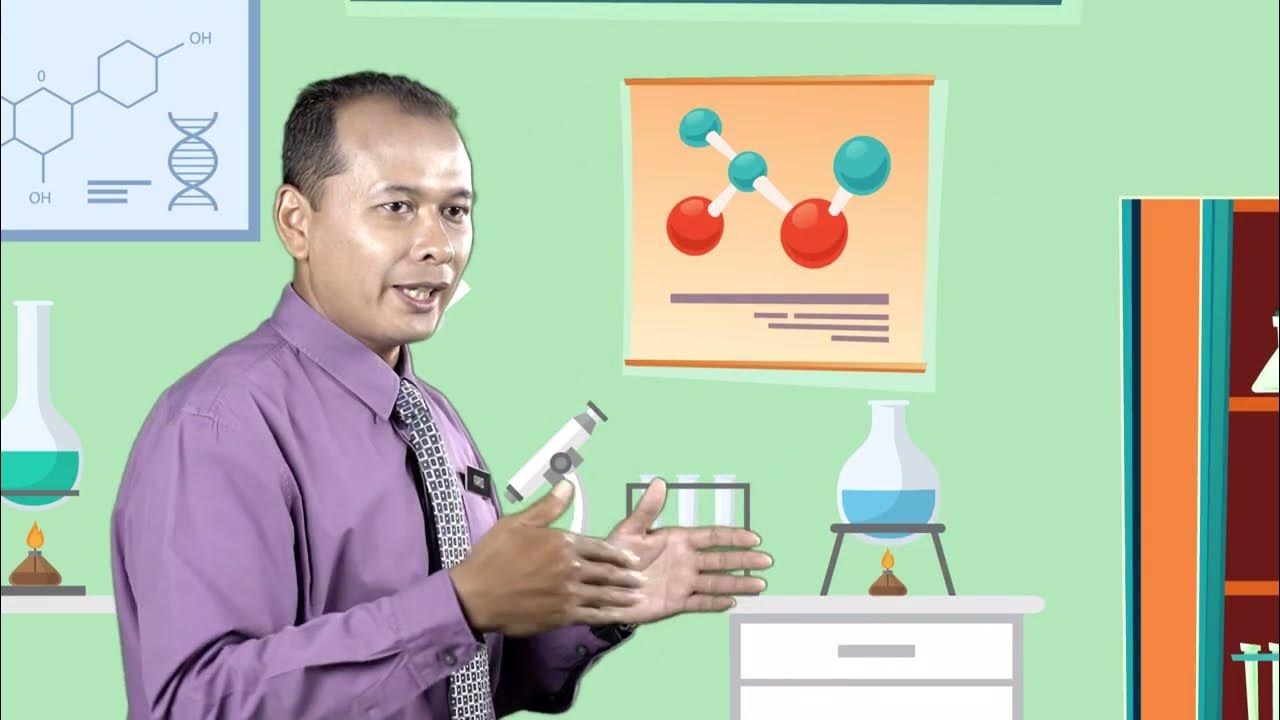UNSUR, SENYAWA DAN CAMPURAN (PART 1_
Summary
TLDRThis educational video on chemistry introduces key concepts about elements, compounds, and mixtures. It explains the fundamental differences between elements, which are pure substances that cannot be broken down further, and compounds, which are formed by the combination of different elements. The video also covers the periodic table, atoms, molecules, and various types of compounds, such as organic and inorganic compounds. It highlights the importance of understanding these concepts in chemistry and their practical applications in everyday life, like in food, medicine, and the environment.
Takeaways
- 😀 Understanding the difference between elements, compounds, and mixtures is essential for learning chemistry.
- 😀 An element is a pure substance made of only one type of atom and cannot be broken down further.
- 😀 Examples of elements include gold and iron, which are represented by their symbols in the periodic table.
- 😀 Elements are categorized into three groups: metals, non-metals, and metalloids (semi-metals).
- 😀 Metals are typically strong, conduct electricity, and are malleable (e.g., aluminum, lead).
- 😀 Non-metals, on the other hand, are not malleable, lack shine, and do not conduct electricity well (e.g., carbon, nitrogen).
- 😀 Metalloids have properties of both metals and non-metals, such as being brittle but can conduct electricity under certain conditions (e.g., silicon, arsenic).
- 😀 The periodic table organizes elements based on their properties, making it easier to study them.
- 😀 Molecules can form from the combination of the same or different atoms, leading to elements (same type) or compounds (different types).
- 😀 Compounds like water (H2O) and carbon dioxide (CO2) are made up of two or more different elements chemically bonded together.
- 😀 Organic compounds primarily consist of carbon and hydrogen (e.g., glucose, methane), while inorganic compounds may involve metals or non-metals (e.g., salt, water).
Q & A
What is the importance of understanding the difference between elements, compounds, and mixtures?
-Understanding the difference between elements, compounds, and mixtures is crucial in chemistry because it helps in recognizing the properties and reactions of different substances. This knowledge forms the foundation for understanding chemical reactions and the behavior of substances.
What is an element and can it be divided into smaller substances?
-An element is a pure substance that cannot be divided into smaller substances through chemical means. Examples include gold and iron.
How do scientists assign names and symbols to elements?
-Scientists assign names and symbols to elements by using a system based on Latin names and specific rules. For example, the element carbon has the symbol 'C' because the first letter of its name is used as the symbol.
What are the three groups of elements based on their properties?
-The three groups of elements are metals, nonmetals, and metalloids. Metals are strong, shiny, and conduct electricity, while nonmetals are brittle, dull, and poor conductors. Metalloids have properties in between metals and nonmetals.
Can you provide examples of metals, nonmetals, and metalloids?
-Examples of metals include aluminum, beryllium, and lead. Nonmetals include carbon, oxygen, and nitrogen, while metalloids include boron, silicon, and arsenic.
What is the periodic table, and why is it important?
-The periodic table is a chart that organizes all known elements based on their properties and atomic structure. It helps chemists understand relationships between elements and predict their behavior in reactions.
What are atoms and what are their components?
-Atoms are the smallest units of an element. They consist of protons (positively charged particles) and neutrons (neutral particles) in the nucleus, with electrons (negatively charged particles) moving around the nucleus.
What is the difference between a molecule of an element and a molecule of a compound?
-A molecule of an element consists of two or more atoms of the same element bonded together (e.g., O2 for oxygen), while a molecule of a compound consists of atoms from different elements bonded together (e.g., H2O for water).
What is the definition of a compound, and can you give examples?
-A compound is a substance formed from two or more different elements chemically bonded together. Examples include water (H2O), carbon dioxide (CO2), and glucose (C6H12O6).
What is the difference between organic and inorganic compounds?
-Organic compounds are primarily made up of carbon and hydrogen atoms, such as glucose (C6H12O6) and methane (CH4). Inorganic compounds are formed from other elements, like sodium chloride (NaCl) and water (H2O), and do not typically contain carbon-hydrogen bonds.
Outlines

هذا القسم متوفر فقط للمشتركين. يرجى الترقية للوصول إلى هذه الميزة.
قم بالترقية الآنMindmap

هذا القسم متوفر فقط للمشتركين. يرجى الترقية للوصول إلى هذه الميزة.
قم بالترقية الآنKeywords

هذا القسم متوفر فقط للمشتركين. يرجى الترقية للوصول إلى هذه الميزة.
قم بالترقية الآنHighlights

هذا القسم متوفر فقط للمشتركين. يرجى الترقية للوصول إلى هذه الميزة.
قم بالترقية الآنTranscripts

هذا القسم متوفر فقط للمشتركين. يرجى الترقية للوصول إلى هذه الميزة.
قم بالترقية الآنتصفح المزيد من مقاطع الفيديو ذات الصلة

GCSE Chemistry Revision "Elements, Compounds and Mixtures"

UNSUR, SENYAWA, DAN CAMPURAN - IPA KELAS 8 SMP KURIKULUM MERDEKA

Form 1 | Science | DLP | Periodic Table | DLP0012

Perubahan Kimia Materi

GCSE Science Revision Chemistry "Elements, Compounds and Mixtures"

Unsur, Senyawa, dan Campuran Kelas 8 | IPA Bab 5 Kurikulum Merdeka - Lengkap
5.0 / 5 (0 votes)
